Uphill climbs, imposing walls, centuries of history and beautiful views: Photos from our visit to Acrocorinth, the largest castle in the Peloponnese

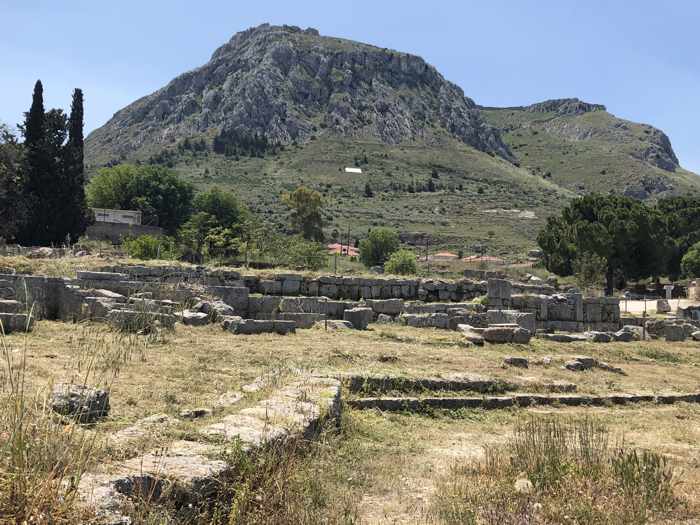
Acrocorinth Castle, top, occupies the peak of a 575-meter (1,880-foot) mountain that rises on the southwest side of the Ancient Corinth archaeological site, above. We explored the castle during a daytrip to historic sites in the Corinth area in May 2022.
Formidable fortress: I call it the Rock of Ages, because there’s an incredibly long history behind Acrocorinth, an impressive ages-old castle that sits astride a monolithic peak in the Corinth region of the Peloponnese.
Dating to pre-Christian times, the mountaintop site was the Acropolis of Ancient Corinth, a wealthy and influential city-state that was one of the biggest and most important cities in Greece, with a population topping 90,000 in 400 B.C. Over the centuries since, the stronghold has been ruled by the Romans, Byzantines, Franks, Knights of Saint John, Venetians and Ottomans.
During our drive from the Corinth Canal to the castle, it was easy to see why Acrocorinth was such a prized property for empires of the past to acquire and control. The huge rock rises at a strategic position along crossroads of major trade, travel and military routes, and its high location provides commanding views of northeastern Peloponnese and two important waterways, the Gulf of Corinth and the Saronic Gulf.
Acrocorinth is the largest castle in the Peloponnese, and its vast size immediately became apparent when we got out of our car in a parking area partway up the mountain and gazed up at the lower fortification walls. Imposing and tall, the stone structures extend almost 3,000 meters (nearly 10,000 feet) along the fortress perimeter, and enclose interior space of more than 240,000 square meters (59 acres). Even without knowing those startling statistics, we were struck by how absolutely enormous and intimidating the castle appeared from outside. It felt just as big once we got inside, too, and we didn’t even get to see all of the interior.
This short film by Travel and Drones was released in early December 2022. It presents dramatic and breathtaking aerial views of Acrocorinth and the nearby Corinth area of the Peloponnese
We managed to wander around Acrocorinth’s interior for nearly two hours before we felt too tuckered out to continue, thanks to the combination of our jet lag and all the walking (much of it on steps and slopes) under sunny skies and a temperature of 24 C (75 F). While we had been hoping to climb to the summit to check out the scenic vistas and look at the Aphrodite temple, a tower and the ancient fountain spring, we feared we would wilt along the way, and decided to head into the city of Corinth for lunch instead.
Even though we missed seeing a large part of the fortress’s upper grounds, we had a fascinating time. There are intriguing monuments and artefacts from antiquity and each era that the castle was ruled by a different empire — “the sanctuary of Aphrodite with an early Christian basilica on its ruins, the fountain of Ano Peirene, Byzantine cisterns, the Frankish tower, a Venetian church, mosques, Turkish houses and fountains,” a passage on the Ancient Corinth website points out.
In May, it was exhilarating to stroll around since the grounds were vibrant and lovely with foliage, wildflowers, tall grasses and fields of wheat swaying in the breeze. There was so much lush and thick greenery, some of the ruins were obscured or partially hidden — nature appeared to be reclaiming the land. Views of the Corinth countryside and Gulf of Corinth were wonderful.
Scroll down to see photos from our visit. If you’re interested in learning more about the history of Acrocorinth, here are a few excellent website resources with articles, historic timelines, maps, photos and videos:
♦ the Acrocorinth entry on Picturesque-Peloponnese.com
♦ the Acrocorinth chapter of the Kastrologos Castles of Greece website
♦ the ExploreCorinth.gr website section Acrocorinth: The Acropolis of Ancient Corinth
♦ the Acrocorinth page on the website AncientCorinth.net
♦ the Travel.gr photo tour A Day in Acrocorinth, the imposing fortress of the Peloponnese
♦ the OnRoadsUncharted.com blog post Guardian of the Peloponnese | A Guide to Acrocorinth
Arriving at Acrocorinth
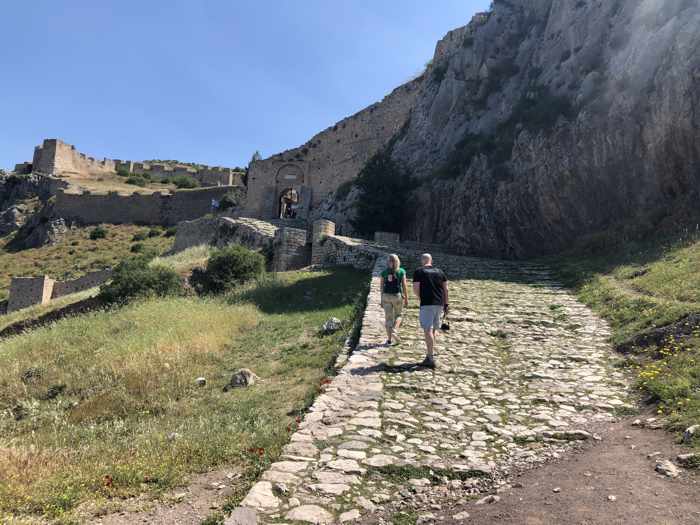
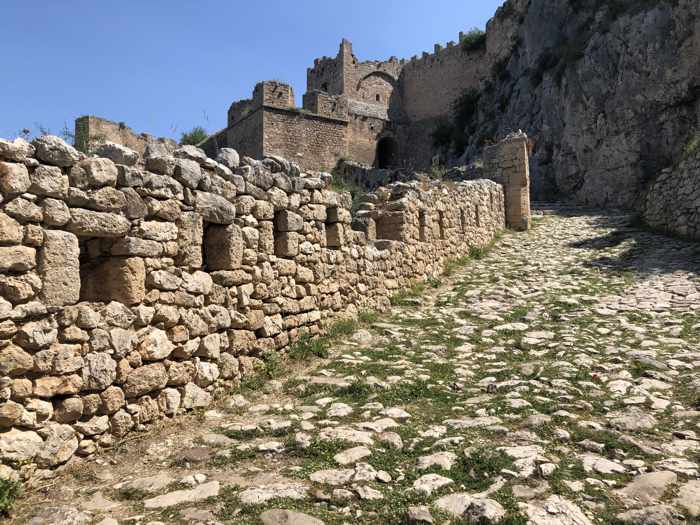
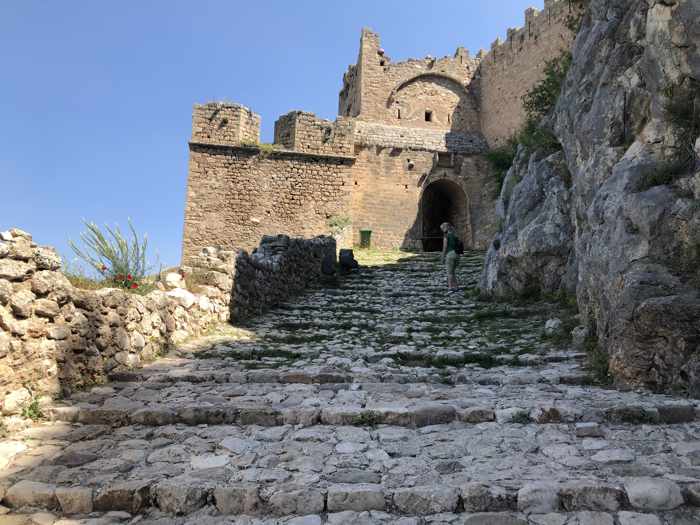
Above, views of the cobblestone path that leads from the parking area to the castle’s first entrance gate (there are three gates in total). Although we were wearing sturdy hiking shoes, we found the stones quite slippery underfoot, and had to step slowly and cautiously while climbing uphill, taking even greater care walking back down. Inside the castle, there is a lot more uphill walking, on steps, slopes and uneven terrain. If you plan to visit, wear shoes with soles that grip well. Be aware that if you have balance or mobility issues, the climb into and back out of the castle could be treacherous. We saw many visitors wobbling and some stumbling on the paths. If you walk up or down the sides of the steps, you can hold onto walls or rocks to sturdy yourself on the cobblestones.
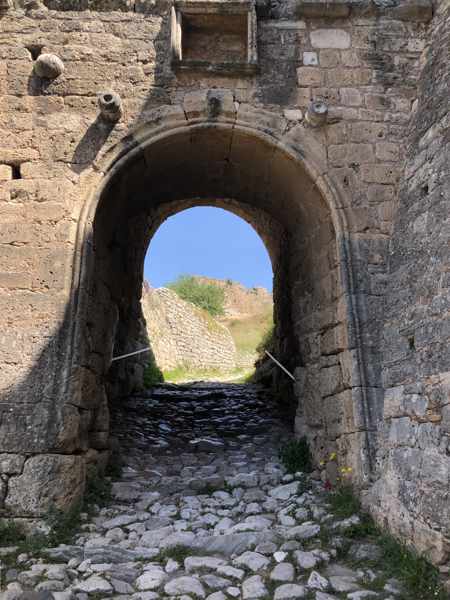
The cobblestone path through the second gate
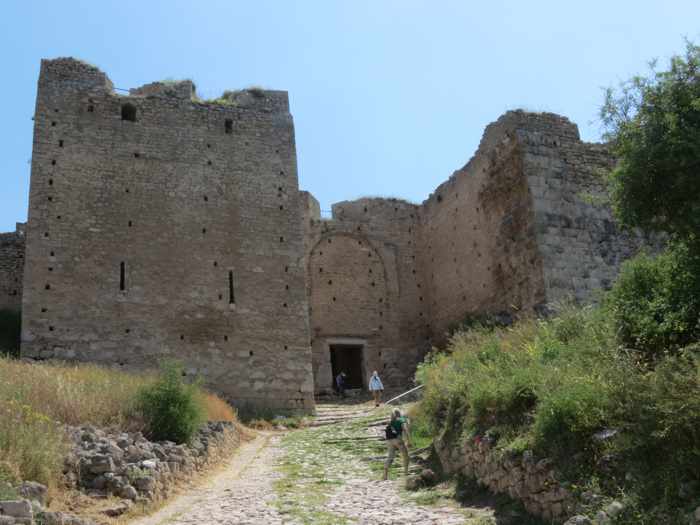
Approaching the mammoth third — and final — entrance gate
The massive fortification walls
Historians believe the first castle walls on Acrocorinth were built during the reign of the tyrant Periander, who ruled from 627 to 585 B.C. Over the centuries, some conquerors destroyed the fortifications, while others reconstructed them or added more. Any time I looked at the immense fortifications, I couldn’t help but wonder who piled all the heavy stones together, and how they were even able to perform the backbreaking work at the tops of cliffs and down the sides of steep slopes. It would have required Herculean effort to build, tear down or reconstruct those thick, tall ramparts and defensive walls.
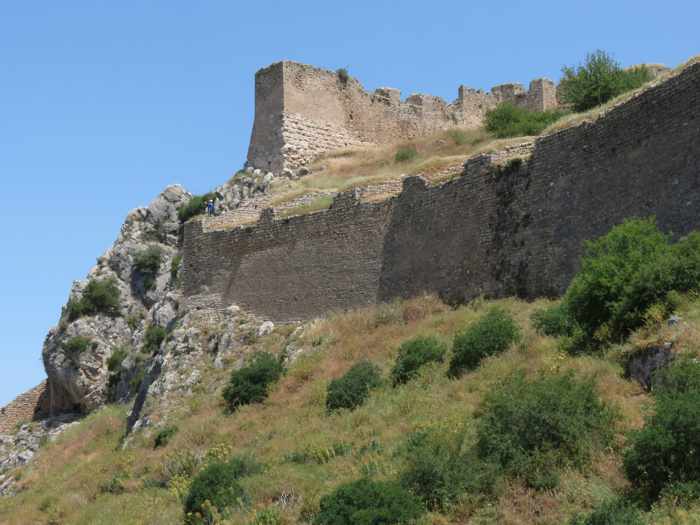
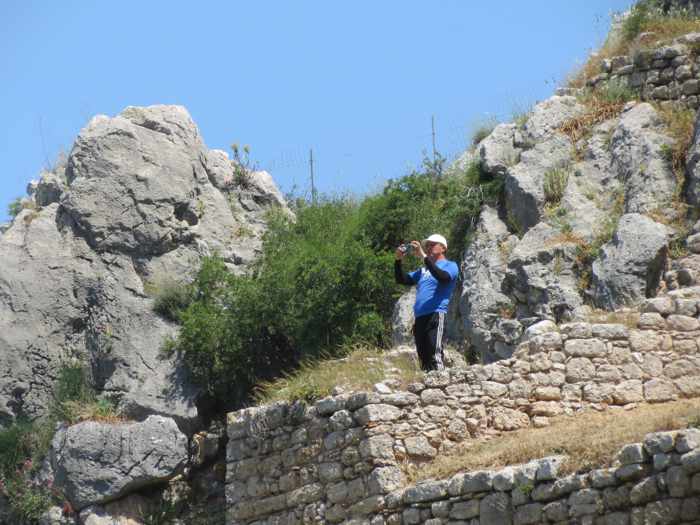
To get a sense of perspective of the enormous size of some of the castle walls, consider that the tourist taking a photo, above, is barely visible in the top photo.

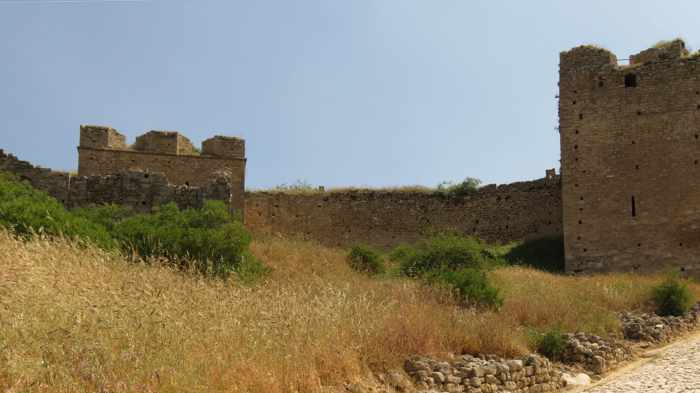
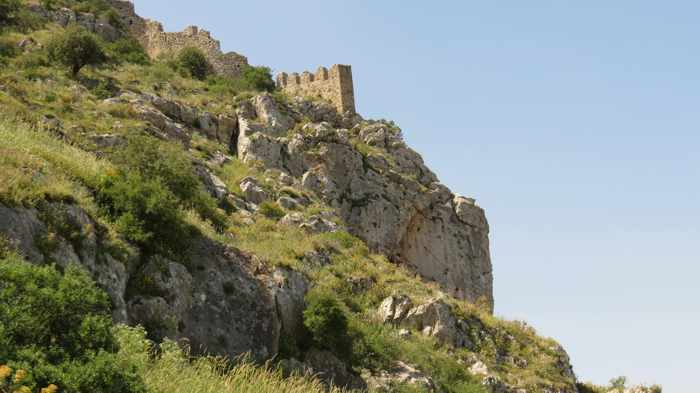
The interior grounds, monuments and ruins
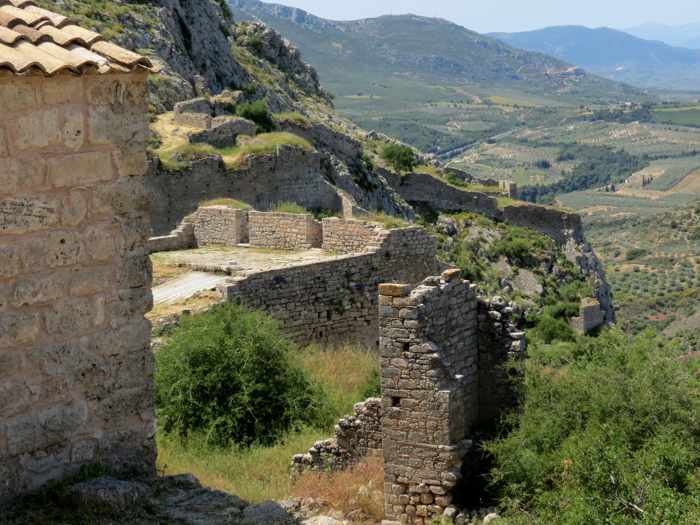
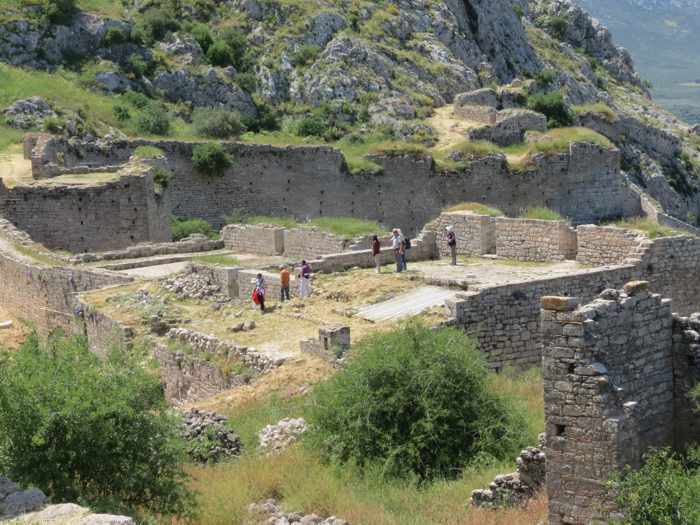

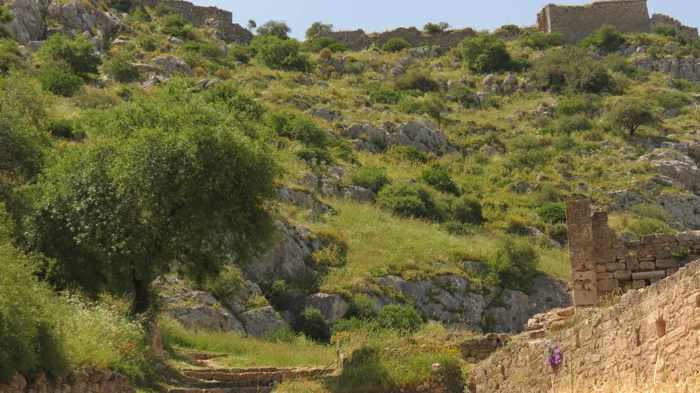
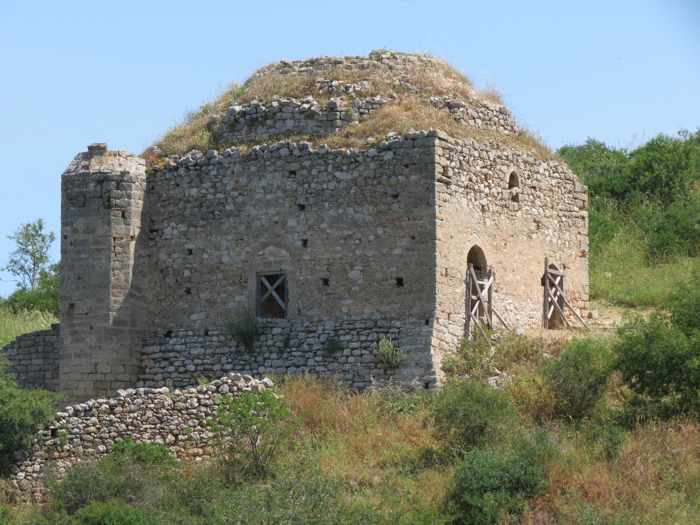
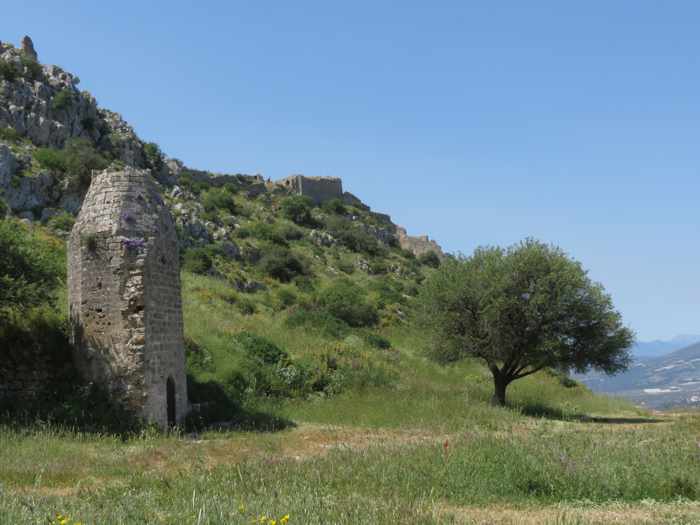
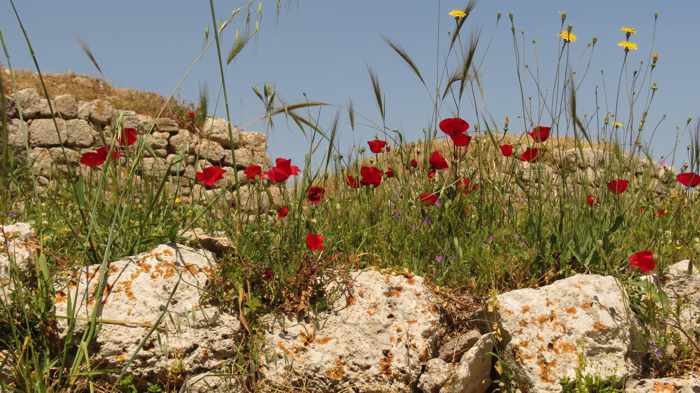
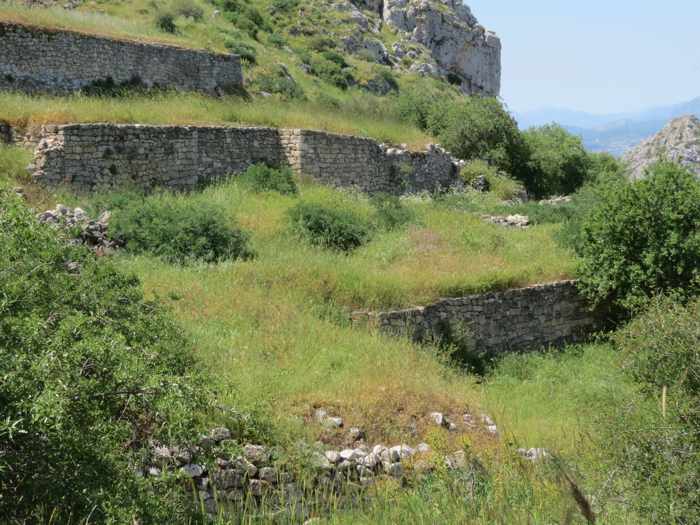
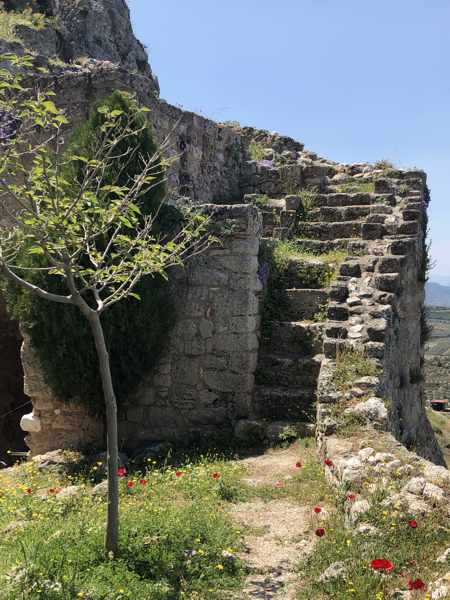
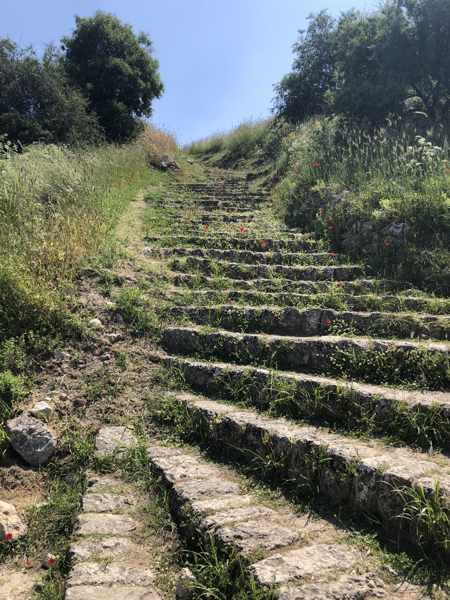
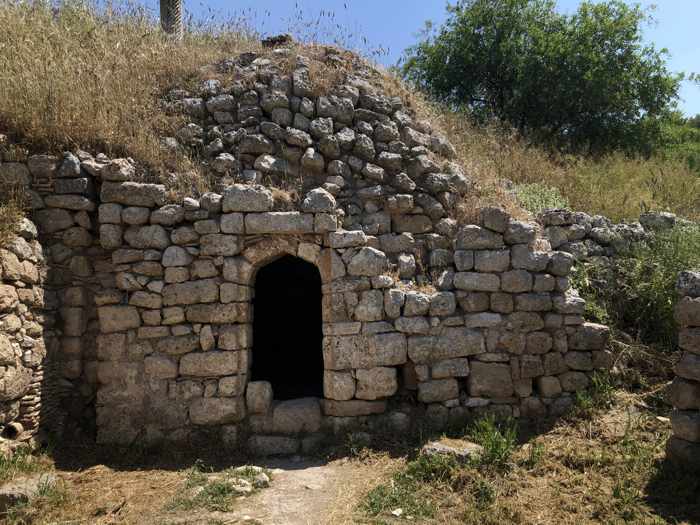
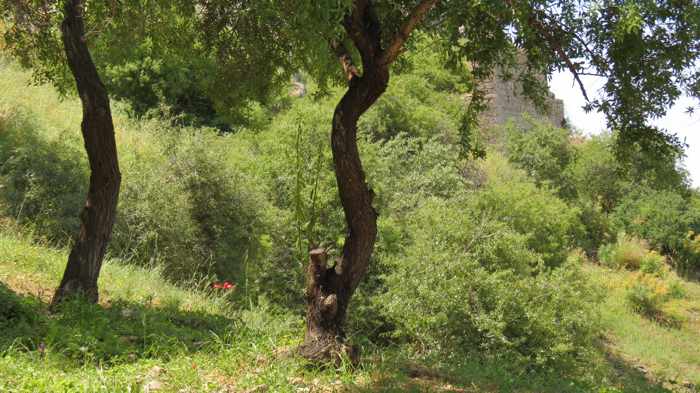
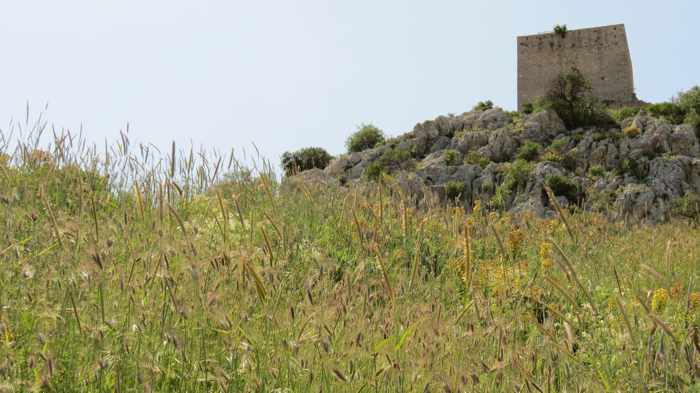
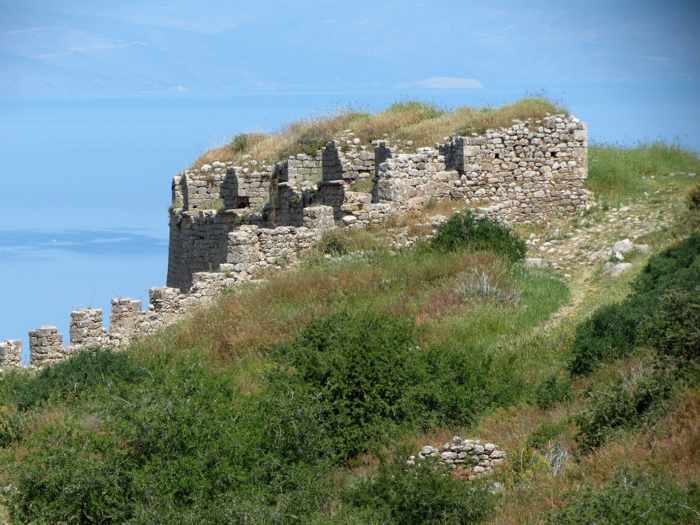
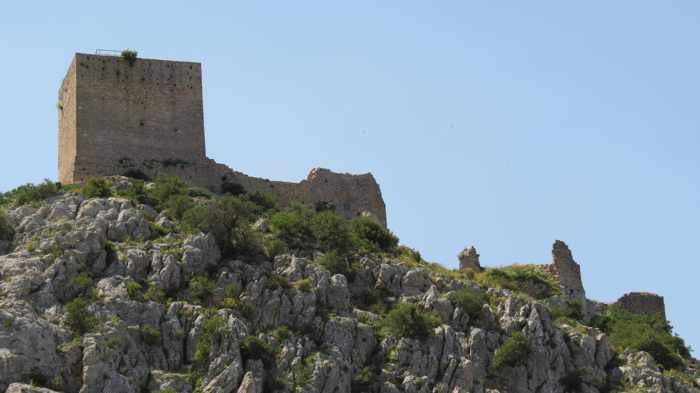
Above, a tower and other structures on the upper-most points of the peak, where visitors can explore the remains of a sanctuary and temple originally dedicated to the goddess Aphrodite, and the spring fountain of Ano Peirene. Unfortunately, we didn’t make it to the top, so we don’t have any photos from that level of the fortress.
Agios Dimitrios church
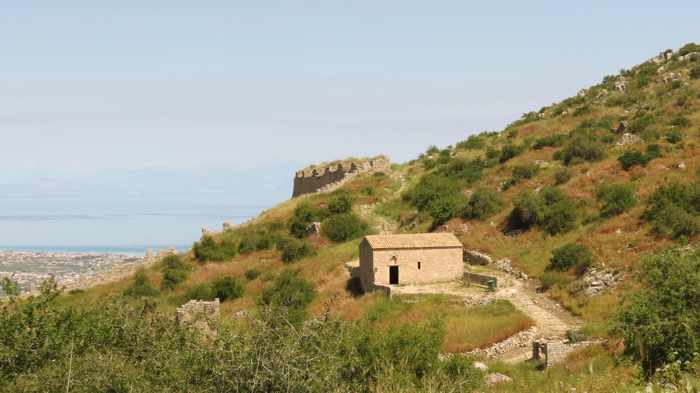
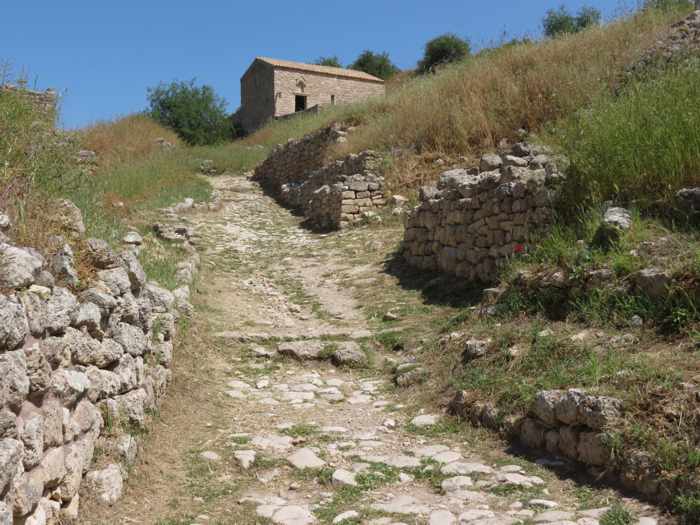
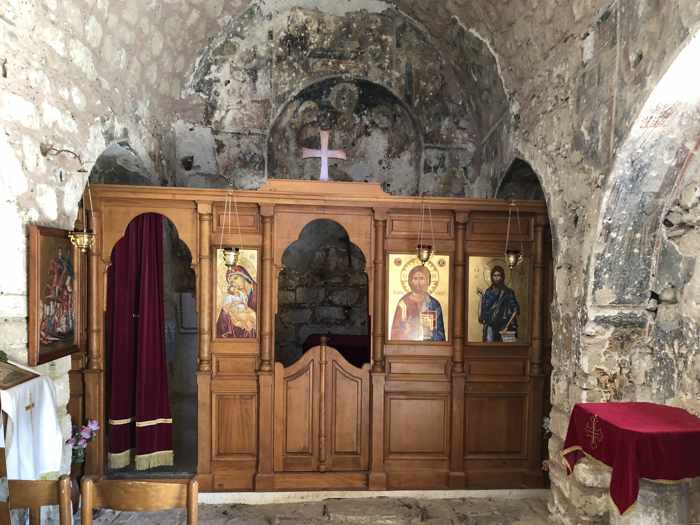
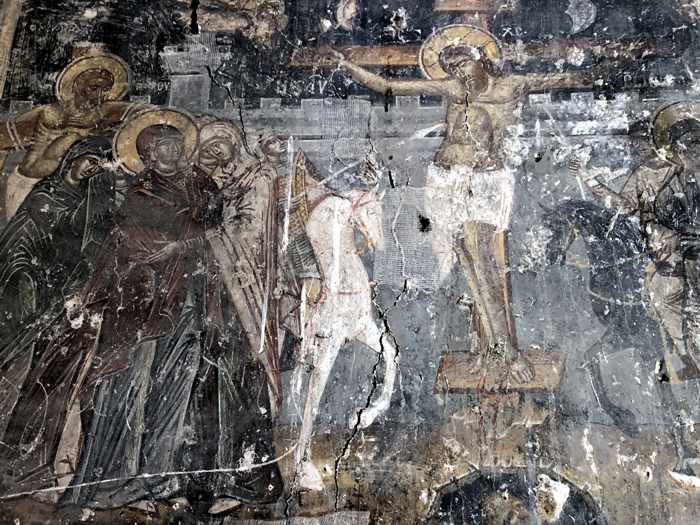
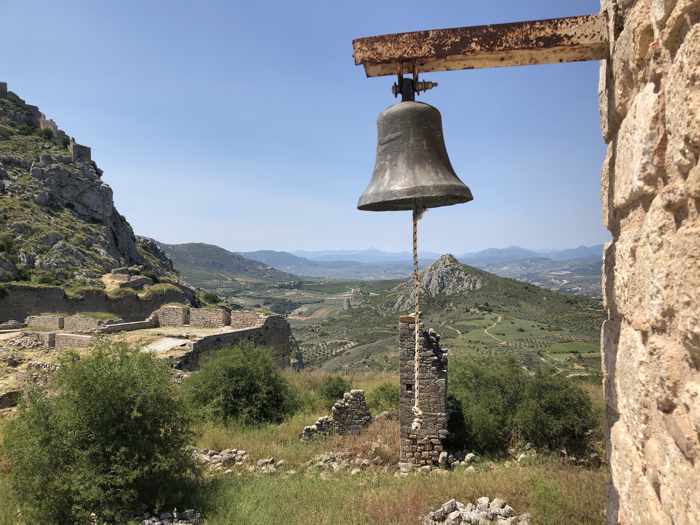
Above, views of the Venetian-era Agios Dimitrios Church, its interior and one of its wall frescos, and the church bell
Views from Acrocorinth
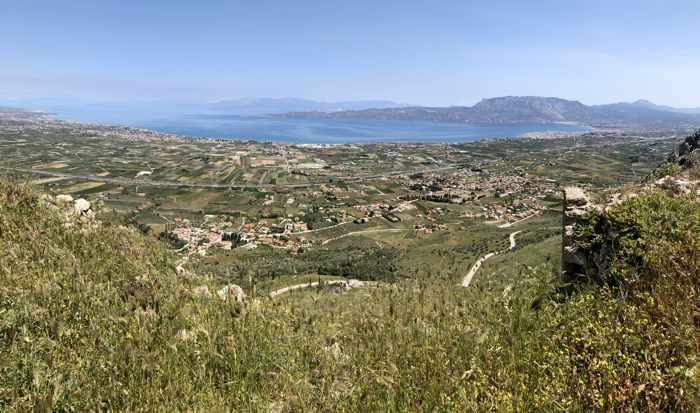
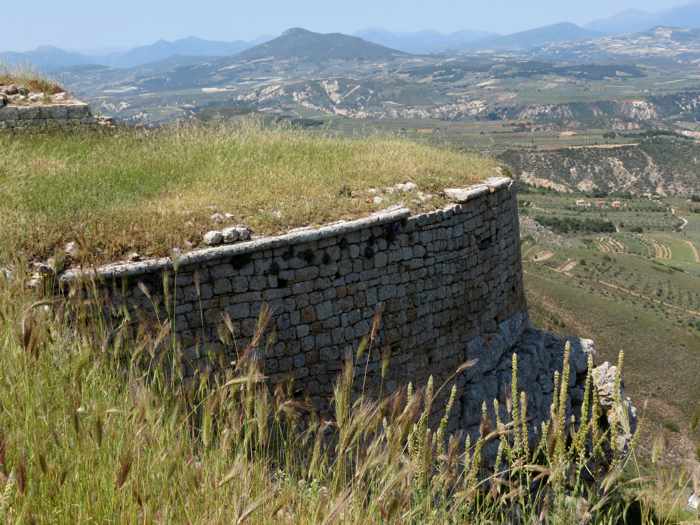

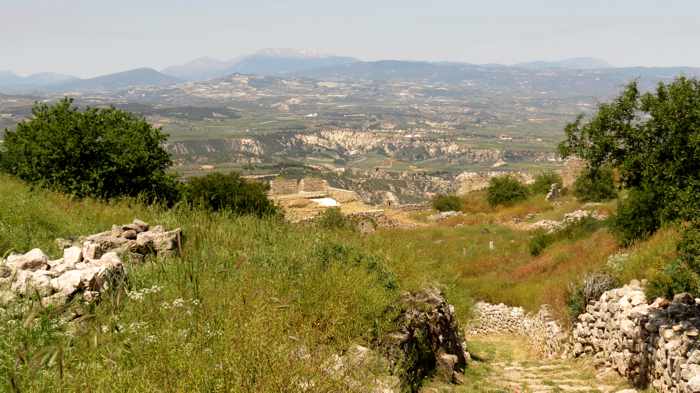
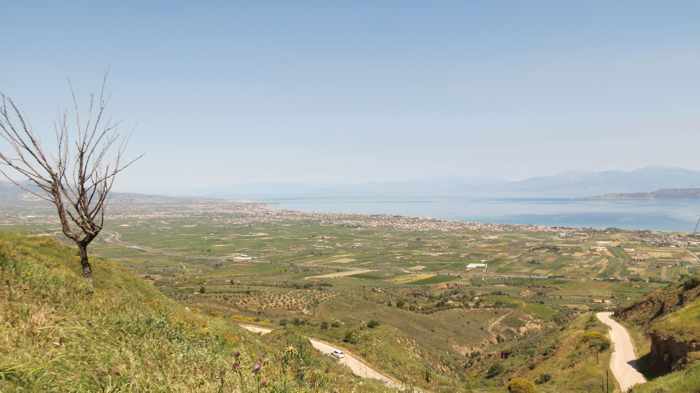
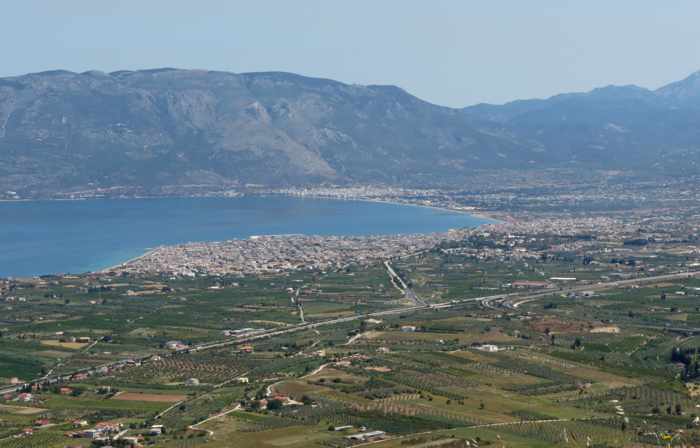
Above, some of the countryside views from the castle. The bottom photo shows the small cities of Corinth (foreground) and Loutraki (across the bay at the foot of the mountains), where we stayed for the first three days of our vacation.
Acrocorinth views of Penteskoufi
From Acrocorinth, visitors can see another nearby peak that is also crowned with a castle — Penteskoufi (also known as the Montesquieue Castle).
It was built by the Franks in 1205 as a strategic maneuver in their efforts to conquer Acrocorinth, which was held at the time by the Byzantine ruler, Leo Sgouras. It took several years for the would-be invaders to prevail. In 1208, as the Franks moved closer to capturing control of Acrocorinth by cutting off its access routes and supply chains, Sgouras committed suicide by riding his horse off a cliff. When supplies finally ran out a year later, Acrocorinth surrendered to the Franks.
Penteskoufi is a square fortress with a tower and six cannon ports. A trail to the castle apparently starts at the Acrocorinth parking area (though we didn’t see it), but the Kastrologos website says the route up the 476-meter peak is difficult and strenuous, and can be dangerous.
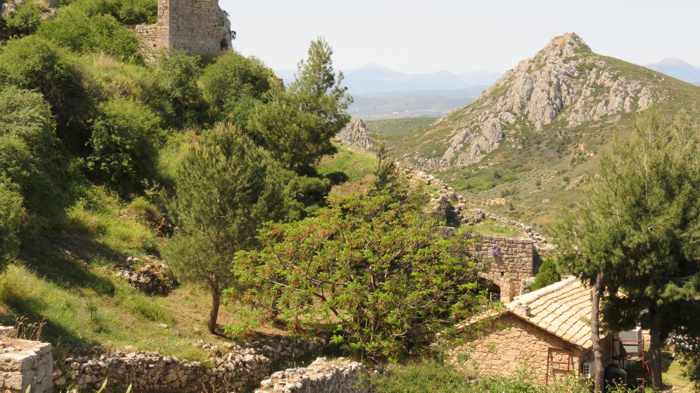
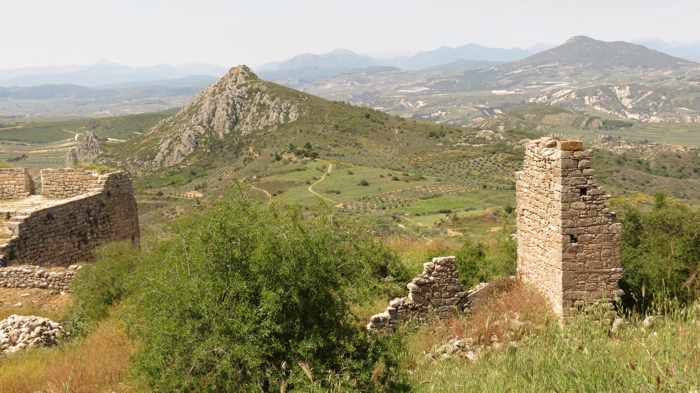
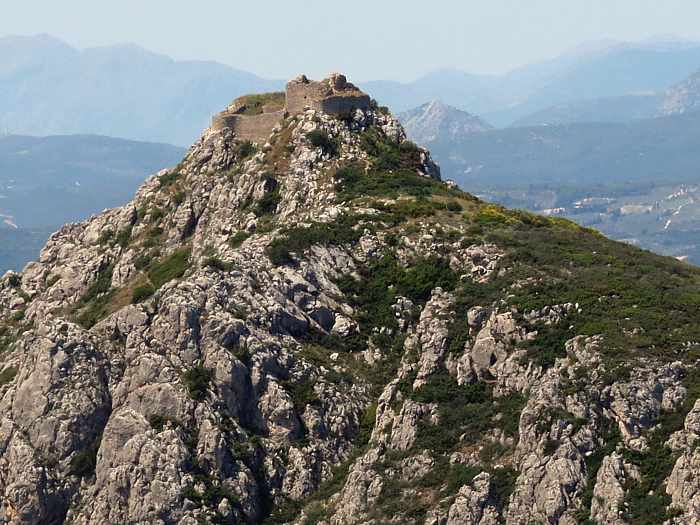




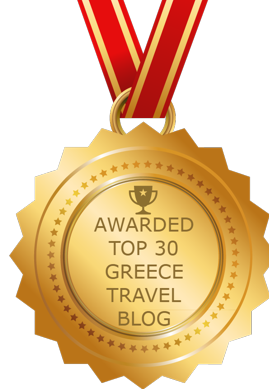

0 Comments
1 Pingback